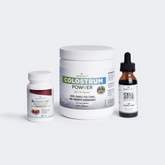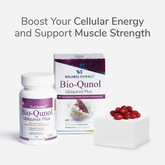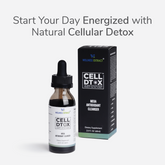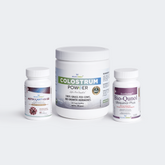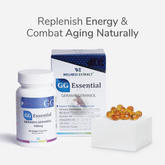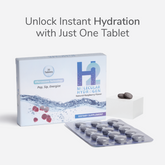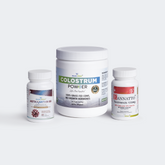5 Foods with as Much Omega-3 as Salmon (and They're Not Fish)
Estimated Reading Time: 7 minutes
|When you think of Omega-3s, salmon is likely the first food that comes to mind. It’s often praised as the go-to source of heart-healthy fat. But what if fish isn’t your thing? Whether you're vegetarian, vegan, or just exploring plant-based options, can you still get the same benefits?
The answer is yes and that’s where it gets interesting.
While salmon is rich in the long-chain Omega-3s your body loves, there are plant-based foods that can come surprisingly close in terms of total Omega-3 content. These non-fish sources mainly offer ALA, an Omega-3 that your body can convert (at least partially) into the beneficial types found in fish.
In this blog, we'll explore the following topics:
-
What Omega-3 fatty acids are and why they matter for your health
-
Why salmon is considered the gold standard for Omega-3 intake
-
Five powerful non-fish foods that pack an impressive Omega-3 punch
-
How do these foods compare to salmon in terms of nutritional value
-
Tips on how to include them in your everyday meals
Whether you prefer plant-based food or just looking to add more variety to your diet, this guide will help you make smart, healthy choices without relying on fish.
What are Omega-3 Fatty Acids?
Omega-3 fatty acids might sound like just another buzzword in the health world, but they’re actually some of the most essential fats your body needs. Moreover, it is important to know that your body can’t make them on its own, so you have to get them through your food.
There are commonly 3 main types of Omega-3s:
-
ALA (Alpha-Linolenic Acid): This one’s found in plant-based foods like flaxseeds, chia seeds, and walnuts. Know its benefits in the section below.
-
EPA (Eicosapentaenoic Acid): Mostly found in fatty fish like salmon, it’s a powerhouse when it comes to supporting heart health.
-
DHA (Docosahexaenoic Acid): Found in fish and algae, DHA is the brain’s best friend. It helps with memory, mood, and overall cognitive function.
So, why do these Omega-3s matter a lot to human health?
The answer is: Omega-3s come with a list of benefits as mentioned below that make them hard to ignore.
-
They help reduce inflammation
-
They keep your heart healthy
-
They boost brain function
-
They promote better skin texture
In short: They're like the VIPs of the nutrition world, supporting everything from your joints to your mood.
Why is Salmon the Ultimate Benchmark for Omega-3s?
Packed with long-chain Omega-3s like EPA and DHA, salmon has earned its place as the nutritional gold standard for Omega-3 intake. These fatty acids are easily absorbed by your body and actively support heart, brain, and skin health.
How Much Omega-3 Does Salmon Really Have?
A 3.5-ounce (100g) serving of wild salmon provides about 2.2g of Omega-3s, while farmed varieties can offer up to 2.3g or even 4.5g in larger fillets. King (Chinook) salmon tops the charts among wild types.
Now that you know why Omega-3s are so important, let’s dive into some plant-powered foods that can help you get your daily dose without needing fish on your plate!
5 Plant-Based Omega-3 Sources That Stand Up to Salmon
Let’s break down what makes each one special.
1. Flaxseeds: Tiny Seeds with Big Omega-3 Power
Flaxseeds are one of the richest plant-based sources of ALA. To get the full benefit, choose ground flaxseeds, as whole seeds, often pass through the digestive system without releasing all their nutrients. Flaxseed oil, even more potent, delivers significantly higher amounts of Omega-3s per serving.
-
Dosage: One tablespoon of ground flaxseed provides about 1.8 grams of ALA. Flaxseed oil contains about 7 grams per tablespoon.
-
How to use: Stir into smoothies, yogurt, oatmeal, or sprinkle on toast. Flaxseed oil is great for salad dressings, but avoid using it for high-heat cooking, it doesn’t tolerate heat well.
2. Chia Seeds: Omega-3s with Extra Fiber
Chia seeds are nutritional multitaskers rich in ALA, fiber, calcium, and plant-based protein. Their ability to absorb liquid and form a gel-like texture makes them especially good for digestion and satiety.
-
Dosage: Two tablespoons (30 grams) provide roughly 5 grams of ALA, which is more Omega-3 than a standard serving of wild salmon.
-
How to use: Add to overnight oats, smoothies, or mix into plant-based puddings. If soaked in liquid, they form a gel-like texture that’s great for recipes or digestion.
3. Walnuts: The Only Nut with Notable Omega-3s
Among all nuts, walnuts are the only variety that delivers a notable amount of Omega-3s. They're also packed with antioxidants and polyphenols that support brain and heart health, making them a great choice for snacking or meal enrichment.
-
Dosage: A one-ounce serving (about 12–14 halves) delivers 2.5 grams of ALA.
-
How to use: Snack on them raw, add to oatmeal or salads, or blend into walnut butter for a nutritious spread.
4. Hemp Seeds: A Balanced Omega Fat Source
Hemp seeds, or hemp hearts, provide a well-balanced ratio of Omega-6 to Omega-3 fats, which helps reduce inflammation. They’re also a complete protein source, offering all nine essential amino acids; a rare trait in plant-based foods.
-
Dosage: Three tablespoons offer approximately 2.6 grams of ALA.
-
How to use: Sprinkle over smoothie bowls, mix into yogurt, or blend into protein balls or homemade granola.
5. Soybean Oil: A Common Cooking Oil with Omega-3 Benefits
Though often overlooked, soybean oil is widely used in cooking and contributes to Omega-3 intake. It's also high in Omega-6, so balancing your diet with Omega-3-rich foods is key to maintaining a healthy ratio.
-
Dosage: One tablespoon provides around 0.92 grams of ALA.
-
How to use: Suitable for sautéing, baking, or as a base in dressings and marinades.
Moving forward, here’s a quick look at how salmon compares to top non-fish Omega-3 foods.
Comparing Omega-3 Levels in Salmon & Top Non-Fish Foods
Have a quick look:
|
Comparison of Omega-3 Content in Salmon and Non-Fish Alternatives |
|||
|
Food Source |
Typical Serving Size |
Total Omega-3s (grams) |
Main Omega-3 Type |
|
Wild Salmon |
3.5 oz (100 g) |
2.2 |
EPA + DHA |
|
Farmed Salmon |
3.5 oz (100 g) |
2.3 |
EPA + DHA |
|
Flaxseeds (ground) |
1 tbsp (7 g) |
1.8 – 2.0 |
ALA |
|
Flaxseed Oil |
1 tbsp (15 mL) |
7.0 |
ALA |
|
Chia Seeds |
2 tbsp (30 g) |
5.0 |
ALA |
|
Walnuts |
1 oz (~1/4 cup) |
2.5 |
ALA |
|
Hemp Seeds |
3 tbsp (30 g) |
2.6 |
ALA |
|
Soybean Oil |
1 tbsp (15 mL) |
0.92 |
ALA |
*tbsp for tablespoon; oz for an ounce
Now that you know the non-fish food source of Omega-3, let's explore the health benefits they offer.
7 Health Benefits of Omega-3s from Non-Fish Foods
Plant-based Omega-3s, particularly ALA found in seeds, nuts, and oils, offer a wide range of health benefits. Below is a list of the significant advantages:
1. Improves Heart Health
ALA can support cardiovascular health by reducing LDL (bad) cholesterol, lowering blood pressure, and improving overall lipid profiles.
2. Regulates Blood Sugar and Aids Digestion
The high fiber content in some of these foods slows carbohydrate digestion, helps stabilize blood sugar levels, and supports gut health.
3. Reduces Inflammation and Oxidative Stress
ALA and antioxidants in these foods can help lower chronic inflammation, a risk factor in many diseases, including arthritis, diabetes, and heart disease.
4. Supports Brain and Cognitive Function
Although ALA is less efficiently converted to DHA than fish-derived sources, studies suggest some brain benefits, especially in low-fish diets (walnuts and hemp seeds).
5. Promotes Skin Health
ALA helps maintain skin hydration and elasticity. These foods contain additional nutrients that support skin structure and healing.
6. May Have Anti-Cancer Potential
Certain compounds found in Omega-3-rich seeds have antioxidant and hormone-modulating effects that may help reduce cancer risk. For example, flaxseeds contain lignans, phytoestrogens, and powerful antioxidants linked to reduced risk of cancer, especially breast cancer.
7. Supports Bone and Muscle Health
Omega-3s may enhance calcium absorption and muscle repair, especially when paired with nutrients like vitamin K or protein.
The Bottom Line
You don’t have to rely on fish to get your daily dose of Omega-3s. Nature offers plenty of plant-based options, like flaxseeds, chia seeds, walnuts, hemp seeds, and soybean oil; that are rich in ALA to support your heart, brain, and skin.
With a little mindfulness, it’s easy to include these ingredients in your everyday meals. Think about smoothies, salads, breakfast bowls, or snacks. Small changes can make a big difference. A well-balanced, plant-powered diet doesn’t just meet your Omega-3 needs, it makes healthy eating feel simple, nourishing, and naturally satisfying.
Disclaimer: This information is for general guidance and shouldn't replace professional advice. If you’re thinking about making big changes to your diet, it’s a good idea to chat with your doctor or a nutritionist to figure out what’s best for you.
References
1. Flaxseed oil (no date). https://www.mountsinai.org/health-library/supplement/flaxseed-oil#:~:text=Flaxseed%20oil%20is%20often%20used,as%20medications%20and%20other%20supplements.
2. Gál, K. (2025) The complete guide to omega-3-rich foods. https://www.medicalnewstoday.com/articles/323144.
3. LD, M.W.R. (2024) What are the forms of hemp and what are their health benefits? https://www.medicalnewstoday.com/articles/308044.




















